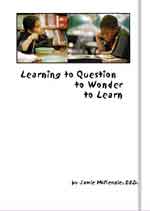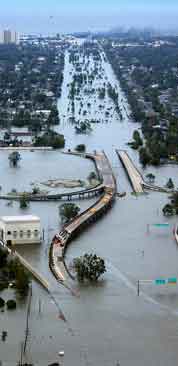|
|
| Vol 16|No 1|October|2006 | |

fno.org
| Please feel free to e-mail this article to a friend, a principal, a parent, a colleague, a teacher librarian, a college professor, a poet, a magician, a vendor, an artist, a juggler, a student, a news reporter or anyone you think might enjoy it. | |
The Image Blockade and Triumph of the New Puritansby Jamie McKenzieWhen a government blocks students from using Google to find images, that decision constitutes censorship of the highest order. Educators and parents should scream loud and long in protest against this heavy-handed effort to restrict what students may see. The riches being withheld from view are a tragic loss. |
 While the Web may offer objectionable pornographic images, blocking all images means students may not access photographs, paintings, posters and charts that are basic to understanding history and their world. Restricting access to information is a betrayal of fundamental democratic principles, a tactic worthy only of an oppressive regime. |
| After investing billions to network schools and provide students with "a window to the world" bureaucrats are now busily installing shutters to make sure students can see nothing but the pristine. There is nothing new about censorship, but schools have done well resisting it in the past when it was a matter of access to books and controversial reading materials. Suddenly with the Net we are witnessing the collapse of fundamental rights.
There have always been strong-willed radical groups that would like to control what all students may read and see. While they speak up to shelter their own children, they are not content until the offending books or images are taken away from all. When bureaucrats pander to these groups by installing unreasonable restrictions, the rest of the citizens should protest vehemently. Censorship of Images is Theft Restricting access to images amounts to theft. Students in a democratic society should have open but responsible access to the visual treasures of the society. Images are essential building blocks for the formulation of political beliefs as well as the understanding of every subject area, whether it be science, social studies or art. The blockade of images amounts to the triumph of one puritanical segment of the society that is imposing its will and values upon the rest of the society. Open but Responsible Access? Schools can adopt AUPs (Acceptable Use Policies) that define responsible use of the network. The AUP specifies the behaviors that are permitted and those that are prohibited. The AUP makes violations a matter of discipline. If students break the rules, they are subject to a range of consequences, one of which might be loss of access to the network for a time period. Both students and parents must sign an agreement stipulating that they understand the rules. Parents stipulate that they will help the school enforce the rules and will back the principle of responsible use. Example: Bellingham (WA) Public Schools at http://www.bham.wednet.edu/technology/techpolicies.htm No Pornography Allowed Long before the Internet, students have been intrigued by images from Playboy and other sources deemed unacceptable by school authorities. I can recall confiscating such images as a young administrator and contacting parents when warranted back in the seventies. The school response was measured and adjusted to fit the specific incident and the types of images. Also before the Internet, images and words on T-shirts and other types of clothing became an issue for many schools, as students sometimes expressed political beliefs or displayed raw and offensive sexual material or words. School officials responded with disciplinary codes that outlined what kinds of words and images would be permitted. Violations were punished. In the States, the banning of symbols of political protest by schools was contested in the courts and found unconstitutional (Tinker v. Des Moines - 1969), but bans against sexual material and gang-related symbols have been upheld. The point here is that schools have both the authority and the clout to enforce acceptable use policies. Students should not be allowed to view pornography in school and should be punished for violations. When formulating rules for student access in Bellingham, we simply told students they could not display anything on a screen that they were not permitted to wear on a T-shirt. No pornography should be allowed in school. If the school takes responsibility for enforcing that expectation, it is unnecessary to block Google and the important visual treasures of the culture. Banning all of Google images is lazy, expedient and dangerous.
Censorship of Images is Mind Control There are powerful groups that would like to keep us from seeing flag-draped coffins returning from Iraq or dead bodies floating in the flood waters of New Orleans. They would like to conceal images of police dogs being used on prisoners or civil rights demonstrators in Birmingham. They would like to re-write history, clean it up and erase embarrassing moments. They would even like to re-write the present, showing only those aspects of reality that might win public approval. And so we are given a "clean war" with battle-ground restrictions on news coverage to minimize the awareness of civilian casualties. When the press starts to show the carnage and brewing civil war, the powers complain that news coverage is "too negative" thereby hoping to intimidate the media into creating a positive spin on negative events. Photo from Wikipedia . . . Lessons from the Taliban Democracy suffers when puritanical extremists impose their values upon the rest of a society. The Taliban banned all kinds of images, imagery, dancing, modern music and activities like schooling girls. Early Puritans coming to America, New Zealand and Australia in search of religious freedom were quick to deny it to those with opposing or differing beliefs. Puritans of both centuries and various religions share an intolerance for diverse beliefs as well as an appetite for dictating what others may not do. When conservative segments of society impose restrictions upon the reading and viewing habits of others, they move toward revival of the harsh moral strictures that were basic to the Spanish and Italian fascisms of the 1930s, movements that sometimes combined church and government to enforce social mores and limit individual freedom and choice.
In some countries tolerance is painted by the New Puritans as weakness, and many aspects of modern life are judged as sinful and decadent. If these elements could have their way, there would be book and movie banning along with a general cleansing of a cultural landscape that is considered evil. It is appalling to watch governments siding with these New Puritans, imposing restrictions on the access to information that severely limit what the young can learn and see. Responsible access as outlined earlier in this article is much more consistent with democratic principles. The statue to the left is called "The Signer" and is meant to represent the patriots who signed the Declaration of Independence, the document that set in motion the great American attempt to replace tyranny with individual freedom and democratic principles. |
|
|
Credits: The photographs in this article were shot by Jamie McKenzie unless otherwise noted. |
|
You can read sample chapters and consider the Table of Contents. Click here.

